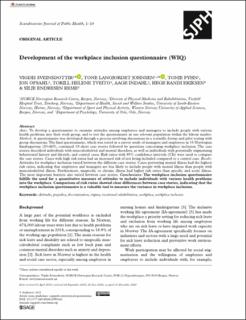| dc.contributor.author | Sveinsdottir, Vigdis | |
| dc.contributor.author | Johnsen, Tone Langjordet | |
| dc.contributor.author | Fyhn, Tonje | |
| dc.contributor.author | Opsahl, Jon | |
| dc.contributor.author | Tveito, Torill Helene | |
| dc.contributor.author | Indahl, Aage | |
| dc.contributor.author | Eriksen, Hege Randi | |
| dc.contributor.author | Reme, Silje Endresen | |
| dc.date.accessioned | 2021-03-30T13:39:07Z | |
| dc.date.available | 2021-03-30T13:39:07Z | |
| dc.date.created | 2020-12-16T10:01:22Z | |
| dc.date.issued | 2021 | |
| dc.identifier.citation | Sveinsdottir, V., Johnsen, T. L., Fyhn, T., Opsahl, J., Tveito, T. H., Indahl, A., . . . Reme, S. E. (2021). Development of the workplace inclusion questionnaire (WIQ). Scandinavian Journal of Public Health. | en_US |
| dc.identifier.issn | 1403-4948 | |
| dc.identifier.uri | https://hdl.handle.net/11250/2736147 | |
| dc.description.abstract | Aims:
To develop a questionnaire to examine attitudes among employees and managers to include people with various health problems into their work group, and to test the questionnaire in one relevant population within the labour market.
Methods:
A questionnaire was developed through a process involving discussions in a scientific forum and pilot testing with group discussions. The final questionnaire, which was tested in a survey study of managers and employees in 33 Norwegian kindergartens (N=485), contained 10 short case stories followed by questions concerning workplace inclusion. The case stories described individuals with musculoskeletal and mental disorders, as well as individuals with potentially stigmatising behavioural history and lifestyle, and control cases. Risk ratios with 95% confidence intervals (CIs) were used to compare the case stories. Cases with high risk ratios had an increased risk of not being included compared to a control case.
Results:
Attitudes for workplace inclusion varied between the different case stories. Cases portraying mental illness had the highest risk ratios, indicating that employees and managers are less likely to include people with mental illness than people with musculoskeletal illness. Furthermore, unspecific or chronic illness had higher risk ratios than specific and acute illness. The most important barriers also varied between case stories.
Conclusions:
The workplace inclusion questionnaire fulfills the need for a quantitative measure of attitudes to include individuals with various health problems into the workplace. Comparison of risk ratios showed clear differences between case stories, indicating that the workplace inclusion questionnaire is a valuable tool to measure the variance in workplace inclusion. | en_US |
| dc.language.iso | eng | en_US |
| dc.publisher | Sage | en_US |
| dc.rights | Navngivelse 4.0 Internasjonal | * |
| dc.rights.uri | http://creativecommons.org/licenses/by/4.0/deed.no | * |
| dc.title | Development of the workplace inclusion questionnaire (WIQ) | en_US |
| dc.type | Journal article | en_US |
| dc.type | Peer reviewed | en_US |
| dc.description.version | publishedVersion | en_US |
| dc.rights.holder | © Author(s) 2021 | en_US |
| dc.source.journal | Scandinavian Journal of Public Health | en_US |
| dc.identifier.doi | 10.1177/1403494821990241 | |
| dc.identifier.cristin | 1860374 | |
| cristin.ispublished | true | |
| cristin.fulltext | original | |
| cristin.qualitycode | 1 | |

